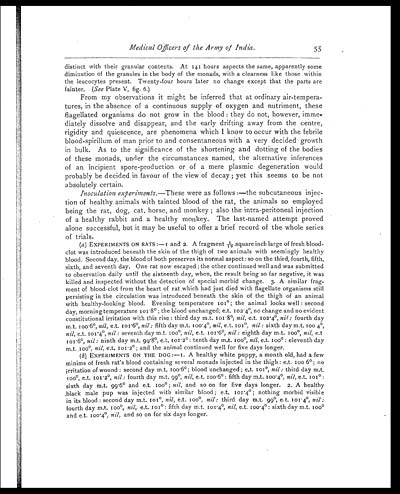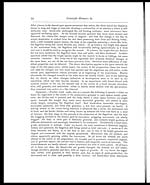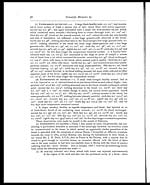Medicine - Institutions > Army health reports and medical documents > Scientific memoirs by medical officers of the Army of India > Part III, 1887 > 7 - On the lately demonstrated blood-contamination and infective disease of the rat and equines in India
(61) Page 55
Download files
Individual page:
Thumbnail gallery: Grid view | List view

Medical Officers of the Army of India.
55
distinct with their granular contents. At 141 hours aspects the same, apparently some
diminution of the granules in the body of the monads, with a clearness like those within
the leucocytes present. Twenty-four hours later no change except that the parts are
fainter. (See Plate V, fig. 6.)
From my observations it might be inferred that at ordinary air-tempera-
tures, in the absence of a continuous supply of oxygen and nutriment, these
flagellated organisms do not grow in the blood: they do not, however, imme-
diately dissolve and disappear, and the early drifting away from the centre,
rigidity and quiescence, are phenomena which I know to occur with the febrile
blood-spirillum of man prior to and consentaneous with a very decided growth
in bulk. As to the significance of the shortening and dotting of the bodies
of these monads, under the circumstances named, the alternative inferences
of an incipient spore-production or of a mere plasmic degeneration would
probably be decided in favour of the view of decay; yet this seems to be not
absolutely certain.
Inoculation experiments. —These were as follows:—the subcutaneous injec-
tion of healthy animals with tainted blood of the rat, the animals so employed
being the rat, dog, cat, horse, and monkey; also the intra-peritoneal injection
of a healthy rabbit and a healthy monkey. The last-named attempt proved
alone successful, but it may be useful to offer a brief record of the whole series
of trials.
(a ) EXPERIMENTS ON RATS:—1 and 2. A fragment 1/10 square inch large of fresh blood-
clot was introduced beneath the skin of the thigh of two animals with seemingly healthy
blood. Second day, the blood of both preserves its normal aspect: so on the third, fourth, fifth,
sixth, and seventh day. One rat now escaped; the other continued well and was submitted
to observation daily until the sixteenth day, when, the result being so far negative, it was
killed and inspected without the detection of special morbid change. 3. A similar frag-
ment of blood-clot from the heart of rat which had just died with flagellate organisms still
persisting in the circulation was introduced beneath the skin of the thigh of an animal
with healthy-looking blood. Evening temperature 101°; the animal looks well: second
day, morning temperature 101.8°; the blood unchanged; e.t. 102.4°, no change and no evident
constitutional irritation with this rise: third day m.t. 101.8°, nil, e.t. 102.4°, nil: fourth day
m.t. 100.6°, nil, e.t, 101.6°, nil: fifth day m.t. 100.4°, nil, e.t. 101°, nil: sixth day m.t. 100.4°,
nil, e.t. 101.4°, nil: seventh day m.t. 100°, nil, e.t. 101.6°, nil: eighth day m.t. 100°, nil, e.t
101.6°, nil: ninth day m.t. 99.8°, e.t. 101.2°: tenth day m.t. 100°, nil, e.t. 100°: eleventh day
m.t. 100°, nil; e.t. 101.2°; and the animal continued well for five days longer.
(b ) EXPERIMENTS ON THE DOG:—I. A healthy white puppy, a month old, had a few
minims of fresh rat's blood containing several monads injected in the thigh: e.t. 100.6°, no
irritation of wound: second day m.t. 100.6°; blood unchanged; e.t. 101°, nil: third day, m.t.
100°, e.t, 101.2°, nil: fourth day m.t. 99°, nil, e.t. 100.6°: fifth day m.t. 100.4°, nil, e.t.: 101°:
sixth day m.t. 99.6° and e.t. 100°; nil, and so on for five days longer. 2. A healthy
black male pup was injected with similar blood; e.t. 101.4°; nothing morbid visible
in its blood: second day m.t. 101°, nil, e.t. 100°, nil : third day m.t. 99°, e. t. 101.4°, nil:
fourth day m.t. 100°, nil, e.t. 101°: fifth day m.t.101.4°, nil, e.t. 100.4°: sixth day m.t. 100°
and e.t. 100.4°, nil, and so on for six days longer.
Set display mode to: Large image | Zoom image | Transcription
Images and transcriptions on this page, including medium image downloads, may be used under the Creative Commons Attribution 4.0 International Licence unless otherwise stated. ![]()
| Permanent URL | https://digital.nls.uk/75004189 |
|---|
| Shelfmark | IP/QB.10 |
|---|---|
| Additional NLS resources: | |




